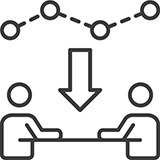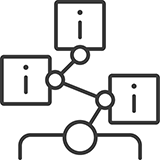The project identified eight key driving forces deemed to substantially influence the development of the two analysed types of platform work by 2030: technology, the labour market, consumer protection, labour regulation, sector regulation, information obligations relating to tax and social insurance authorities, platform ownership/governance, and platform business models. Based on assumed developments of these driving forces, 10 possible future scenarios were derived.
Technology
Technology develops at a moderate pace. 5G mobile technology is available only in the main cities, so that the Internet of Things (IoT) has developed only in these cities for predictive maintenance of buildings or large appliances or for tracking vehicles more systematically. Interconnectivity between technologies has improved but requires further development to arrive at a seamless connectivity and fully integrated solutions. Robotics, including artificial intelligence, develops for businesses. Households and private individuals tend to reject connected technologies to avoid companies’ intrusion into their privacy. Electric vehicles have reached a high level of market maturity, with widespread adoption of electric cars and bikes. Autonomous vehicles, in contrast, are still in a trial phase, with pilot projects in some areas, but they are not widely deployed.
Competencies and capacities to develop and implement algorithms, data storage and data analytics have developed and are widespread but have not yet reached their full potential in terms of both technological development and operational deployment in the economy and labour market. 3D printing has reached a substantial level of application in some manufacturing industries and some countries, driven in part by the need to reduce transport to protect the environment. The technology is not common in individual households. Virtual reality is often used for training purposes but not much elsewhere. Augmented reality and blockchain are still being tested, without wide deployment across sectors.
For platform work, a moderate pace of development results in a further concentration of its use in urban areas, while application in more rural areas remains limited. The limitations as regards interconnectivity, algorithms and data analytics hamper the appeal of platform-determined and worker-initiated platform work for business clients; hence, private individuals and households remain the main clientele.
On the demand side, no particular changes in dynamics occur, as the services provided are neither strongly fostered nor hindered by the technological developments. For example, the need for maintenance services is unchanged as replacement parts are not yet 3D-printed by households themselves.
On the supply side, the advances in electric bikes and virtual reality facilitate platform work for a larger group of workers: electric bikes enable less physically fit people to engage in platform-determined work, and virtual reality enriches skills development in worker-initiated platform work.
Labour market
There is continued economic recovery, linked to new business models and new products and services offered both in the traditional and the platform economies. Accordingly, labour demand exceeds supply, which is also due to demographic and societal developments. This enhances workers’ position in the labour market. Workers can choose among employment offers. Employment and working conditions improve as employers strive to secure their workforces. This also holds true for platform work. Both platforms and clients are incentivised to offer good conditions to get their service needs covered.
While the improvement of employment and working conditions benefits platform-determined workers especially, it more generally encourages entrepreneurialism. This is because there is less reluctance to engage in platform work, and more workers take the opportunity to use worker-initiated work strategically to try out self-employment, to learn, and to apply their skills and capacities in the economy (both the traditional and the platform economies). Such attitudes and competences further enhance positive economic development, Europe’s competitive situation and innovation potential.
Consumer protection
Across the EU, Member States have harmonised consumer protection. The regulation clearly establishes that clients can hold platforms liable in case of incidents. The platform might hold the workers responsible subsequently, but clients can never directly approach workers for indemnification. This clarity, in combination with the ‘stronger partner’ (the platforms) being held liable if needed, increases consumers’ willingness to become clients in the platform economy. This further enhances the demand for services mediated through online platforms and apps, and in turn the demand for platform workers.
Platforms will seek ways to minimise their risks. Passing them on to the workers, for example through higher fees, is not possible as there is competition for workers across platforms, and only those offering the best conditions will succeed. Accordingly, platforms buy new insurance products protecting them from such risks, thereby driving growth in the insurance sector. Additionally, they place more emphasis on training workers to ensure better service quality and reduce the risk of incidents for which they might be held liable.
Labour regulation
There is also harmonisation of labour regulation across Member States as regards the employment status of platform workers by platform work type, driven by governments’ intention to better protect workers. There is the rebuttable assumption that workers in platform-determined platform work are employees of the platform and those in worker-initiated platform work are self-employed service providers. Platforms and workers can challenge this default status by providing justification that a different status is applicable. For the majority of workers in platform-determined platform work, this improves their access to employment rights and the enforceability of those rights, which is likely to improve job quality and working conditions, including social protection and representation.
At the same time, the costs of doing business increase for those platforms previously working with self-employed workers. A share of these costs can be passed on to clients, due to the increasing demand for platform-mediated services, but not all. As a result, the perceived value attributed to platform work increases; it is no longer a substantially cheaper service than that provided by the traditional economy. This levels the playing field between the platform and the traditional economies.
Sector regulation
The balance of power between the two economies is also evened by the regulatory clarification that specific sector regulation in terms of market access, certification, standards and so on also applies to platforms if the tasks they facilitate compare to activities in the traditional economy. Accordingly, platforms and their workers are subject to the same requirements as actors in the traditional economy and cannot outcompete them based on lower costs due to avoiding certain investments.
Information obligations regarding tax and social insurance
Across the EU, platforms are subject to the same obligations to report information about tax and social insurance to the authorities, with enforcement regulated and carried out at national level. Workers and clients are informed about this fact and have to agree to the collection and use of their data before entering into business with the platform. As platform-determined workers by default are employees, the platforms have information obligations and transfer workers’ income tax and social insurance contributions to the relevant authorities. Evasion potential is low.
Platform ownership and governance
The increasing demand for platform-mediated services attracts new actors to enter the platform economy. They look for innovative business models to attract workers, as demand for labour is high and supply is decreasing. This fosters the growth of new platform business models that are oriented to create stakeholder value rather than shareholder value. This is facilitated as the platform economy becomes less attractive for shareholder-value-based business models, notably non-EU owned platforms, due the establishment of various areas of regulation.
Governments could provide services of public interest through such platform models, thereby creating employment and improving service provision, for example, in the areas of transport or care. This would be particularly useful in rural areas.
Platforms run as worker cooperatives are flourishing for worker-initiated platform work, so that workers can reap the benefits (for example, by investing the platform’s gains in joint training or marketing activities) rather than financing profit-oriented investors. Furthermore, this ‘networked self-employment’ might further foster entrepreneurial quality and cooperation due to enhanced exchange.
The remaining profit-oriented platforms improve their employment and working conditions to retain their workforce. This benefits platform-determined workers particularly, who tend to depend more on platforms than the worker-initiated workers.
Platform business model
Consumers become more familiar with services mediated through platforms, resulting in increased acceptance and higher competition with similar services in the traditional economy.
Workers find more tasks on offer through platforms, hence increasing the potential to earn income through platform work; at the same time, jobs in the traditional economy might decrease due to the competition from platforms.










